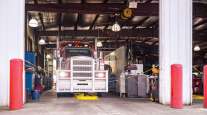Certified Technicians Required for Dealer Warranty Work
This story appears in the Jan. 30 print edition of Transport Topics.
The 2010 technology power plants and the new emissions systems represented such a dramatic break from the past that only technicians certified by original equipment manufacturers have been able to work on them while they are still under warranty, truck dealers said.
Even companies that have 2,000 trucks in their fleets and formerly did all their maintenance and repairs in-house — including warranty work — are sending their trucks to dealers and OEM distributors for complicated work inside the new engines and emissions systems.
Two truck makers said that only technicians they certify can work on vehicles they manufacture and are under warranty.
“DTNA dealers, [for] chassis and engines, and distributors, [for] engines, continue to remain the . . . only place to receive factory-trained, authorized maintenance or repair service on new DTNA vehicles,” said Bob Correll, general manager of central service for Daimler Trucks North America, Portland, Ore., which builds Freightliner and Western Star trucks, as well as Detroit Diesel engines.
DTNA spokesman David Giroux said the company also can certify technicians for fleet customers.
“In some cases, for the fleet customer, DTNA will qualify the customer to perform in-house warranty [work],” he said. “In those cases, technical training is made available to the customer through DTNA’s Training Department.”
“Our Service Level Authorization policy indicates that the dealer must use a certified technician to perform warranty repairs,” said Brian Mulshine, Navistar’s director of field service.
“Navistar trains its own dealer technicians and, in some cases, dealers have trainers that travel to fleets, but only to provide basic introduction training,” Mulshine told Transport Topics.
“For fleets that do their own in-house maintenance, they can receive training and certification via Navistar’s online training portal or by attending a Navistar-authorized training session in person,” Mulshine added.
He said that “repairs performed with a person not certified can be adjusted or reversed upon warranty-claim audit.”
Mulshine added, “Our Tech Service group also reviews technicians.
Ozark Motor Lines Inc., Memphis, Tenn., is an example of a fleet that used to do most of its own maintenance and warranty work until 2010 trucks came on line.
“We try to do 100% of maintenance and repair in-house, though occasionally we’ll get a truck that goes out beyond our service and will break down,” said Glen McDonald, Ozark’s director of maintenance, “but on the new engines, we can do limited work in-house, so we send it to the dealer, Clarke Power Services.”
Clarke Power Services Inc., Cincinnati, said it is an authorized distributor for Detroit Diesel engines and a dealer for Allison Transmission, which builds fully automatic transmissions for heavy-duty trucks.
“That work is pretty specialized. It’s just not what we do, and I don’t think [the manufacturers] would qualify it,” McDonald said. “On the other hand, we do have a Clarke person who’s qualified to work on the new engines, and he comes to our facility every day.”
McDonald also said that his shop took over all work when the warranty expired.
“This gives us a period of training and gets us up to speed,” he said. “We’re doing all of the 2007 engine work now.”
McDonald said Ozark implemented a strategy for dealing with the technologies introduced in the 2002-2004, 2007 and 2010 engines.
“We pre-bought [new trucks a year before the mandates took effect], so that we missed the first year of each new engine while any problems got worked out,” he explained.
Eric Jorgensen, CEO of JX Enterprises Inc., a Peterbilt dealer based in Pewaukee, Wis., said, “If a truck with 2010 technology is still under warranty, only a technician certified by the manufacturer can work on it for the warranty to remain in effect. Most of the trucks with the new technology are still under warranty.”
“There is a lot more to it than before with these new engines, and it’s a big investment to train and certify each technician,” Jorgensen told TT. “These are not $500 classes. It’s more of a multi-thousand-dollar investment for each technician, so that mostly authorized dealers are doing it.”
“The largest fleets can make the investment to do warranty work in-house, though,” he added.
Truck and engine manufacturers had to add new technology three times in the past 10 years — in 2002-2004, 2007 and 2010, as mentioned above — to meet the tough emissions standards set by the U.S. Environmental Protection Agency.
Adding to the complexity, two different technologies are used to meet the 2010 EPA standards.
All of the truck and engine makers except Navistar Inc., Warrenville, Ill., chose selective catalytic reduction technology, which involves adding new components to reduce emissions in the aftertreatment.
Navistar, which builds International trucks and MaxxForce engines, chose what it called “advanced exhaust gas recirculation,” an update of an in-engine solution introduced by all engine makers to meet EPA’s 2002-2004 mandates.
Kyle Treadway, president of Kenworth Sales Co., which has 18 locations in six Mountain and Western states, said fleets doing warranty work need to be mindful of the risks.
“For the warranty to remain in place, the fleets have to provide the required maintenance, and they have to be able to document the maintenance,” Treadway told TT. “It’s integral to the warranty, but they don’t have to come to a dealer for that.”
Kenworth Truck Co., Kirkland, Wash., is a unit of truck maker Paccar Inc., Bellevue, Wash.
Ronald Remp, dealer principal of Wheeling Truck Center, a Volvo dealer in Wheeling, W.Va., said Volvo “has been offering extensive training to fleets, which we also do” on the 2010 technology.
Remp said the training was important because, “If improper maintenance caused a breakdown in the truck or major components, that could void the warranty.”
Volvo and Mack Trucks are both subsidiaries of global truck manufacturer Volvo AB, which has its headquarters in Sweden.
Only the biggest fleets have gone through the effort to get their technicians certified to do all 2010 warranty work in-house.
UPS Inc., which ranks No. 1 on Transport Topics’ Top 100 for-hire carriers in the United States and Canada, does all of its maintenance work in-house.
“UPS has an extensive internal maintenance program,” spokeswoman Elizabeth Rasberry told TT. “We trained all our mechanics for the equipment and vehicles in our fleet.”
She said UPS knows that “maintenance and repair can be more complex on 2010 technology engines, but all staff have been trained accordingly to handle the differences with that equipment.”
UPS also doesn’t have to worry about having a truck break down outside its service area.
“We don’t really come across scenarios where a truck can break down without [UPS] repair service,” she explained. “All UPS facilities have trained mechanics, and we have coast-to-coast coverage as it relates to maintenance and repairs.”
Ryder Supply Chain Solutions, Miami, which ranks No. 12 on the for-hire TT 100, also rarely sends work outside.
“We continually train our technicians through in-house technical trainers and OEM-supplied online or classroom training, based on the equipment mix and identified needs,” said Jeanette McCarty, Ryder’s vice president for maintenance operations and engineering.
“The majority of our work is done in-house at a Ryder-owned-and-operated maintenance facility,” she said. “We perform vehicle maintenance as part of our full-service lease offering for customer-leased vehicles and also on a contract basis for customers who own their own fleets but have chosen to outsource the maintenance.”
McCarty did add that Ryder will “utilize a network of maintenance providers to supplement peak periods of demand and overflow work on an as-needed basis.”
She also said that Ryder chose from “a mix of providers, depending on the particular maintenance need and who can provide the required repair in a quality and cost-effective manner.”
McCarty said that Ryder purchases most trucks directly from manufacturers, which then de-liver them to Ryder locations, without going through dealers for “prep” work.
“The only time you’d see a vehicle sent to a local dealer is if we were looking for aftermarket installation of a non-OEM piece of equipment,” she said.
Michael Jeffress,vice president of maintenance at Maverick USA, Little Rock, Ark., said that his technicians undergo continuous training and education, which include Daimler’s required courses to allow them to perform warranty work on its main engine and truck supplier’s products.
“We do in-house warranty work on the new trucks and engines,” he said. “All of our technicians go through study courses that Daimler has put together to retain our ability to do said warranty work.”
Jeffress said that Maverick technicians don’t “specifically receive certification, but we do have certificates of class completion and such.”
“In regards to 2010 major en-gine repairs,” he said, “when we have them, which is few and far between, we send them to the dealer/distributor group, who has made the investments in training for those sort of repairs. We do this for two reasons: one, to control costs on tools required to work on the new engines; and secondly, to ensure our shop bays are providing the maintenance practices needed to operate our fleet and serve our customers.”
Jeffress added, “The technology is just so new, especially the emission systems, that we continue to send it to dealers.”
Maverick ranks No. 96 on the for-hire TT 100.
Even Gordon Trucking, which operates 1,900 tractors from Pacific, Wash., and ranks No. 64 on the for-hire TT 100, did not want to get involved in 2010 warranty work.
“Typically, fleets won’t handle warranty work on engines and other major components because they have to be certified to do that,” said Kirk Altrichter, vice-president of maintenance for Gordon. “Even if certified, fleets are not going to want to work on internal components. If the equipment is outside warranty, then that’s a different story.”
Altrichter said Gordon called on either engine distributors or truck dealerships to do warranty work: “Really they’re the only two certified to work on the engine.”
He also said, “For other major components under warranty, fleets work out details with component manufacturers and usually work through a dealer to get it done. However, I think there are a lot more fleets doing work on components because manufacturers typically will work with a fleet on that.”
Altrichter said that, for other work, “we want to do 100% of maintenance in-house,” but certified technicians are still necessary.
“It depends on the type of work,” Altrichter said. “If it’s the air conditioning, it requires a technician who’s certified for that work. If it involves tires, the technician has to be trained in [Occupational Safety & Health Administration] standards, and if it’s for brake adjustments, the federal government requires technicians to receive certain training.”




